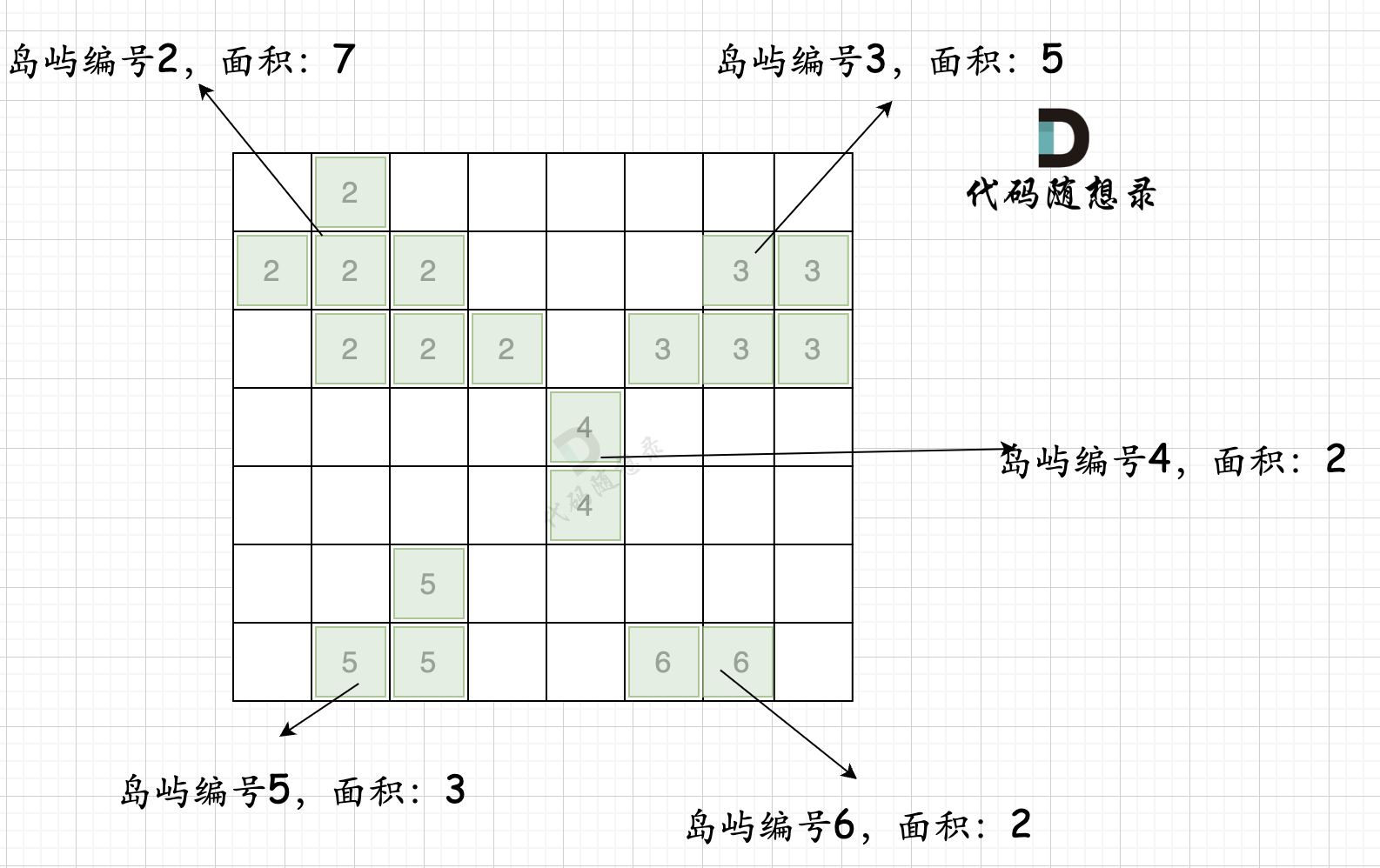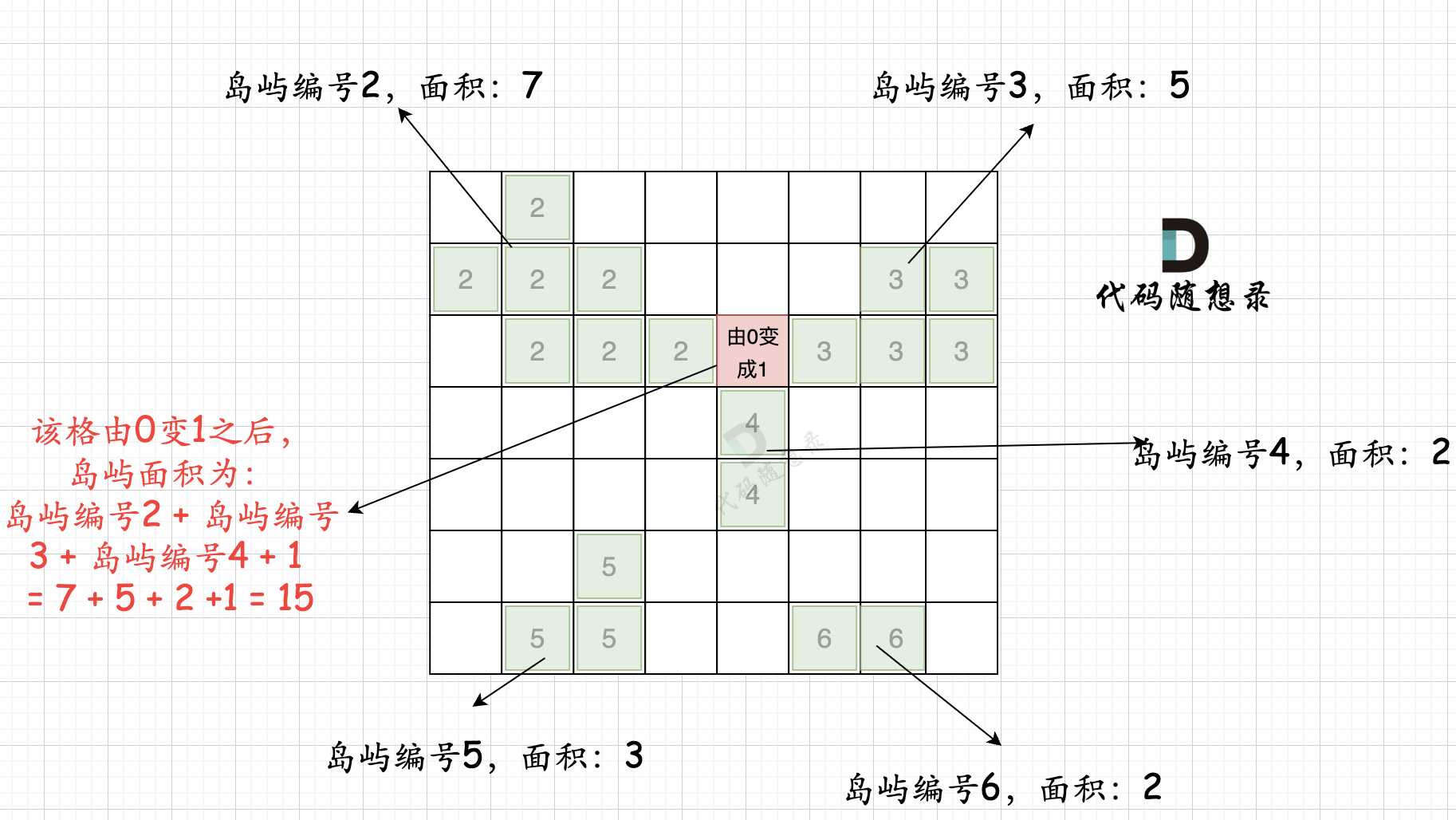- 做项目(多个C++、Java、Go、测开、前端项目) (opens new window)
- 刷算法(两个月高强度学算法) (opens new window)
- 背八股(40天挑战高频面试题) (opens new window)
# 827.最大人工岛
给你一个大小为 n x n 二进制矩阵 grid 。最多 只能将一格 0 变成 1 。
返回执行此操作后,grid 中最大的岛屿面积是多少?
岛屿 由一组上、下、左、右四个方向相连的 1 形成。
示例 1:
- 输入: grid = [[1, 0], [0, 1]]
- 输出: 3
- 解释: 将一格0变成1,最终连通两个小岛得到面积为 3 的岛屿。
示例 2:
- 输入: grid = [[1, 1], [1, 0]]
- 输出: 4
- 解释: 将一格0变成1,岛屿的面积扩大为 4。
示例 3:
- 输入: grid = [[1, 1], [1, 1]]
- 输出: 4
- 解释: 没有0可以让我们变成1,面积依然为 4。
# 思路
本题的一个暴力想法,应该是遍历地图尝试 将每一个 0 改成1,然后去搜索地图中的最大的岛屿面积。
计算地图的最大面积:遍历地图 + 深搜岛屿,时间复杂度为 n * n。
(其实使用深搜还是广搜都是可以的,其目的就是遍历岛屿做一个标记,相当于染色,那么使用哪个遍历方式都行,以下我用深搜来讲解)
每改变一个0的方格,都需要重新计算一个地图的最大面积,所以 整体时间复杂度为:n^4。
如果对深度优先搜索不了解的录友,可以看这里:深度优先搜索精讲 (opens new window)
# 优化思路
其实每次深搜遍历计算最大岛屿面积,我们都做了很多重复的工作。
只要用一次深搜把每个岛屿的面积记录下来就好。
第一步:一次遍历地图,得出各个岛屿的面积,并做编号记录。可以使用map记录,key为岛屿编号,value为岛屿面积 第二步:在遍历地图,遍历0的方格(因为要将0变成1),并统计该1(由0变成的1)周边岛屿面积,将其相邻面积相加在一起,遍历所有 0 之后,就可以得出 选一个0变成1 之后的最大面积。
拿如下地图的岛屿情况来举例: (1为陆地)

第一步,则遍历题目,并将岛屿到编号和面积上的统计,过程如图所示:

本过程代码如下:
int dir[4][2] = {0, 1, 1, 0, -1, 0, 0, -1}; // 四个方向
void dfs(vector<vector<int>>& grid, vector<vector<bool>>& visited, int x, int y, int mark) {
if (visited[x][y] || grid[x][y] == 0) return; // 终止条件:访问过的节点 或者 遇到海水
visited[x][y] = true; // 标记访问过
grid[x][y] = mark; // 给陆地标记新标签
count++;
for (int i = 0; i < 4; i++) {
int nextx = x + dir[i][0];
int nexty = y + dir[i][1];
if (nextx < 0 || nextx >= grid.size() || nexty < 0 || nexty >= grid[0].size()) continue; // 越界了,直接跳过
dfs(grid, visited, nextx, nexty, mark);
}
}
int largestIsland(vector<vector<int>>& grid) {
int n = grid.size(), m = grid[0].size();
vector<vector<bool>> visited = vector<vector<bool>>(n, vector<bool>(m, false)); // 标记访问过的点
unordered_map<int ,int> gridNum;
int mark = 2; // 记录每个岛屿的编号
bool isAllGrid = true; // 标记是否整个地图都是陆地
for (int i = 0; i < n; i++) {
for (int j = 0; j < m; j++) {
if (grid[i][j] == 0) isAllGrid = false;
if (!visited[i][j] && grid[i][j] == 1) {
count = 0;
dfs(grid, visited, i, j, mark); // 将与其链接的陆地都标记上 true
gridNum[mark] = count; // 记录每一个岛屿的面积
mark++; // 记录下一个岛屿编号
}
}
}
}
2
3
4
5
6
7
8
9
10
11
12
13
14
15
16
17
18
19
20
21
22
23
24
25
26
27
28
29
30
31
32
这个过程时间复杂度 n * n 。可能有录友想:分明是两个for循环下面套这一个dfs,时间复杂度怎么回事 n * n呢?
其实大家可以仔细看一下代码,n * n这个方格地图中,每个节点我们就遍历一次,并不会重复遍历。
第二步过程如图所示:

也就是遍历每一个0的方格,并统计其相邻岛屿面积,最后取一个最大值。
这个过程的时间复杂度也为 n * n。
所以整个解法的时间复杂度,为 n * n + n * n 也就是 n^2。
当然这里还有一个优化的点,就是 可以不用 visited数组,因为有mark来标记,所以遍历过的grid[i][j]是不等于1的。
代码如下:
int dir[4][2] = {0, 1, 1, 0, -1, 0, 0, -1}; // 四个方向
void dfs(vector<vector<int>>& grid, int x, int y, int mark) {
if (grid[x][y] != 1 || grid[x][y] == 0) return; // 终止条件:访问过的节点 或者 遇到海水
grid[x][y] = mark; // 给陆地标记新标签
count++;
for (int i = 0; i < 4; i++) {
int nextx = x + dir[i][0];
int nexty = y + dir[i][1];
if (nextx < 0 || nextx >= grid.size() || nexty < 0 || nexty >= grid[0].size()) continue; // 越界了,直接跳过
dfs(grid, nextx, nexty, mark);
}
}
public:
int largestIsland(vector<vector<int>>& grid) {
int n = grid.size(), m = grid[0].size();
unordered_map<int ,int> gridNum;
int mark = 2; // 记录每个岛屿的编号
bool isAllGrid = true; // 标记是否整个地图都是陆地
for (int i = 0; i < n; i++) {
for (int j = 0; j < m; j++) {
if (grid[i][j] == 0) isAllGrid = false;
if (grid[i][j] == 1) {
count = 0;
dfs(grid, i, j, mark); // 将与其链接的陆地都标记上 true
gridNum[mark] = count; // 记录每一个岛屿的面积
mark++; // 记录下一个岛屿编号
}
}
}
}
}
2
3
4
5
6
7
8
9
10
11
12
13
14
15
16
17
18
19
20
21
22
23
24
25
26
27
28
29
30
31
32
不过为了让各个变量各司其事,代码清晰一些,完整代码还是使用visited数组来标记。
最后,整体代码如下:
class Solution {
private:
int count;
int dir[4][2] = {0, 1, 1, 0, -1, 0, 0, -1}; // 四个方向
void dfs(vector<vector<int>>& grid, vector<vector<bool>>& visited, int x, int y, int mark) {
if (visited[x][y] || grid[x][y] == 0) return; // 终止条件:访问过的节点 或者 遇到海水
visited[x][y] = true; // 标记访问过
grid[x][y] = mark; // 给陆地标记新标签
count++;
for (int i = 0; i < 4; i++) {
int nextx = x + dir[i][0];
int nexty = y + dir[i][1];
if (nextx < 0 || nextx >= grid.size() || nexty < 0 || nexty >= grid[0].size()) continue; // 越界了,直接跳过
dfs(grid, visited, nextx, nexty, mark);
}
}
public:
int largestIsland(vector<vector<int>>& grid) {
int n = grid.size(), m = grid[0].size();
vector<vector<bool>> visited = vector<vector<bool>>(n, vector<bool>(m, false)); // 标记访问过的点
unordered_map<int ,int> gridNum;
int mark = 2; // 记录每个岛屿的编号
bool isAllGrid = true; // 标记是否整个地图都是陆地
for (int i = 0; i < n; i++) {
for (int j = 0; j < m; j++) {
if (grid[i][j] == 0) isAllGrid = false;
if (!visited[i][j] && grid[i][j] == 1) {
count = 0;
dfs(grid, visited, i, j, mark); // 将与其链接的陆地都标记上 true
gridNum[mark] = count; // 记录每一个岛屿的面积
mark++; // 记录下一个岛屿编号
}
}
}
if (isAllGrid) return n * m; // 如果都是陆地,返回全面积
// 以下逻辑是根据添加陆地的位置,计算周边岛屿面积之和
int result = 0; // 记录最后结果
unordered_set<int> visitedGrid; // 标记访问过的岛屿
for (int i = 0; i < n; i++) {
for (int j = 0; j < m; j++) {
int count = 1; // 记录连接之后的岛屿数量
visitedGrid.clear(); // 每次使用时,清空
if (grid[i][j] == 0) {
for (int k = 0; k < 4; k++) {
int neari = i + dir[k][1]; // 计算相邻坐标
int nearj = j + dir[k][0];
if (neari < 0 || neari >= grid.size() || nearj < 0 || nearj >= grid[0].size()) continue;
if (visitedGrid.count(grid[neari][nearj])) continue; // 添加过的岛屿不要重复添加
// 把相邻四面的岛屿数量加起来
count += gridNum[grid[neari][nearj]];
visitedGrid.insert(grid[neari][nearj]); // 标记该岛屿已经添加过
}
}
result = max(result, count);
}
}
return result;
}
};
2
3
4
5
6
7
8
9
10
11
12
13
14
15
16
17
18
19
20
21
22
23
24
25
26
27
28
29
30
31
32
33
34
35
36
37
38
39
40
41
42
43
44
45
46
47
48
49
50
51
52
53
54
55
56
57
58
59
60
61
# 其他语言版本
# Java
class Solution {
private static final int[][] position = {{-1, 0}, {0, 1}, {1, 0}, {0, -1}}; // 四个方向
/**
* @param grid 矩阵数组
* @param row 当前遍历的节点的行号
* @param col 当前遍历的节点的列号
* @param mark 当前区域的标记
* @return 返回当前区域内 1 的数量
*/
public int dfs(int[][] grid, int row, int col, int mark) {
int ans = 0;
grid[row][col] = mark;
for (int[] current: position) {
int curRow = row + current[0], curCol = col + current[1];
if (curRow < 0 || curRow >= grid.length || curCol < 0 || curCol >= grid.length) continue; // 越界
if (grid[curRow][curCol] == 1)
ans += 1 + dfs(grid, curRow, curCol, mark);
}
return ans;
}
public int largestIsland(int[][] grid) {
int ans = Integer.MIN_VALUE, size = grid.length, mark = 2;
Map<Integer, Integer> getSize = new HashMap<>();
for (int row = 0; row < size; row++) {
for (int col = 0; col < size; col++) {
if (grid[row][col] == 1) {
int areaSize = 1 + dfs(grid, row, col, mark);
getSize.put(mark++, areaSize);
}
}
}
for (int row = 0; row < size; row++) {
for (int col = 0; col < size; col++) {
// 当前位置如果不是 0 那么直接跳过,因为我们只能把 0 变成 1
if (grid[row][col] != 0) continue;
Set<Integer> hashSet = new HashSet<>(); // 防止同一个区域被重复计算
// 计算从当前位置开始获取的 1 的数量,初始化 1 是因为把当前位置的 0 转换成了 1
int curSize = 1;
for (int[] current: position) {
int curRow = row + current[0], curCol = col + current[1];
if (curRow < 0 || curRow >= grid.length || curCol < 0 || curCol >= grid.length) continue;
int curMark = grid[curRow][curCol]; // 获取对应位置的标记
// 如果标记存在 hashSet 中说明该标记被记录过一次,如果不存在 getSize 中说明该标记是无效标记(此时 curMark = 0)
if (hashSet.contains(curMark) || !getSize.containsKey(curMark)) continue;
hashSet.add(curMark);
curSize += getSize.get(curMark);
}
ans = Math.max(ans, curSize);
}
}
// 当 ans == Integer.MIN_VALUE 说明矩阵数组中不存在 0,全都是有效区域,返回数组大小即可
return ans == Integer.MIN_VALUE ? size * size : ans;
}
}
2
3
4
5
6
7
8
9
10
11
12
13
14
15
16
17
18
19
20
21
22
23
24
25
26
27
28
29
30
31
32
33
34
35
36
37
38
39
40
41
42
43
44
45
46
47
48
49
50
51
52
53
54
55
56
# Python
class Solution:
def largestIsland(self, grid: List[List[int]]) -> int:
visited = set() #标记访问过的位置
m, n = len(grid), len(grid[0])
res = 0
island_size = 0 #用于保存当前岛屿的尺寸
directions = [[0, 1], [0, -1], [1, 0], [-1, 0]] #四个方向
islands_size = defaultdict(int) #保存每个岛屿的尺寸
def dfs(island_num, r, c):
visited.add((r, c))
grid[r][c] = island_num #访问过的位置标记为岛屿编号
nonlocal island_size
island_size += 1
for i in range(4):
nextR = r + directions[i][0]
nextC = c + directions[i][1]
if (nextR not in range(m) or #行坐标越界
nextC not in range(n) or #列坐标越界
(nextR, nextC) in visited): #坐标已访问
continue
if grid[nextR][nextC] == 1: #遇到有效坐标,进入下一个层搜索
dfs(island_num, nextR, nextC)
island_num = 2 #初始岛屿编号设为2, 因为grid里的数据有0和1, 所以从2开始编号
all_land = True #标记是否整个地图都是陆地
for r in range(m):
for c in range(n):
if grid[r][c] == 0:
all_land = False #地图里不全是陆地
if (r, c) not in visited and grid[r][c] == 1:
island_size = 0 #遍历每个位置前重置岛屿尺寸为0
dfs(island_num, r, c)
islands_size[island_num] = island_size #保存当前岛屿尺寸
island_num += 1 #下一个岛屿编号加一
if all_land:
return m * n #如果全是陆地, 返回地图面积
count = 0 #某个位置0变成1后当前岛屿尺寸
#因为后续计算岛屿面积要往四个方向遍历,但某2个或3个方向的位置可能同属于一个岛,
#所以为避免重复累加,把已经访问过的岛屿编号加入到这个集合
visited_island = set() #保存访问过的岛屿
for r in range(m):
for c in range(n):
if grid[r][c] == 0:
count = 1 #把由0转换为1的位置计算到面积里
visited_island.clear() #遍历每个位置前清空集合
for i in range(4):
nearR = r + directions[i][0]
nearC = c + directions[i][1]
if nearR not in range(m) or nearC not in range(n): #周围位置越界
continue
if grid[nearR][nearC] in visited_island: #岛屿已访问
continue
count += islands_size[grid[nearR][nearC]] #累加连在一起的岛屿面积
visited_island.add(grid[nearR][nearC]) #标记当前岛屿已访问
res = max(res, count)
return res
2
3
4
5
6
7
8
9
10
11
12
13
14
15
16
17
18
19
20
21
22
23
24
25
26
27
28
29
30
31
32
33
34
35
36
37
38
39
40
41
42
43
44
45
46
47
48
49
50
51
52
53
54
55
56
57
58
59
60
61
# Go
func largestIsland(grid [][]int) int {
dir := [][]int{{0, 1}, {1, 0}, {-1, 0}, {0, -1}}
n := len(grid)
m := len(grid[0])
area := 0
visited := make([][]bool, n)
for i := 0; i < n; i++ {
visited[i] = make([]bool, m)
}
gridNum := make(map[int]int, 0) // 记录每一个岛屿的面积
mark := 2 // 记录每个岛屿的编号
isAllGrid := true
res := 0 // 标记是否整个地图都是陆地
var dfs func(grid [][]int, visited [][]bool, x, y, mark int)
dfs = func(grid [][]int, visited [][]bool, x, y, mark int) {
// 终止条件:访问过的节点 或者 遇到海水
if visited[x][y] || grid[x][y] == 0 {
return
}
visited[x][y] = true // 标记访问过
grid[x][y] = mark // 给陆地标记新标签
area++
for i := 0; i < 4; i++ {
nextX := x + dir[i][0]
nextY := y + dir[i][1]
if nextX < 0 || nextX >= len(grid) || nextY < 0 || nextY >= len(grid[0]) {
continue
}
dfs(grid, visited, nextX, nextY, mark)
}
}
for i := 0; i < n; i++ {
for j := 0; j < m; j++ {
if grid[i][j] == 0 {
isAllGrid = false
}
if !visited[i][j] && grid[i][j] == 1 {
area = 0
dfs(grid, visited, i, j, mark) // 将与其链接的陆地都标记上 true
gridNum[mark] = area // 记录每一个岛屿的面积
mark++ // 更新下一个岛屿编号
}
}
}
if isAllGrid {
return n * m
}
// 根据添加陆地的位置,计算周边岛屿面积之和
visitedGrid := make(map[int]struct{}) // 标记访问过的岛屿
for i := 0; i < n; i++ {
for j := 0; j < m; j++ {
count := 1 // 记录连接之后的岛屿数量
visitedGrid = make(map[int]struct{}) // 每次使用时,清空
if grid[i][j] == 0 {
for k := 0; k < 4; k++ {
// 计算相邻坐标
nearI := i + dir[k][0]
nearJ := j + dir[k][1]
if nearI < 0 || nearI >= len(grid) || nearJ < 0 || nearJ >= len(grid[0]) {
continue
}
// 添加过的岛屿不要重复添加
if _, ok := visitedGrid[grid[nearI][nearJ]]; ok {
continue
}
// 把相邻四面的岛屿数量加起来
count += gridNum[grid[nearI][nearJ]]
// 标记该岛屿已经添加过
visitedGrid[grid[nearI][nearJ]] = struct{}{}
}
}
res = max827(res, count)
}
}
return res
}
func max827(x, y int) int {
if x > y {
return x
}
return y
}
2
3
4
5
6
7
8
9
10
11
12
13
14
15
16
17
18
19
20
21
22
23
24
25
26
27
28
29
30
31
32
33
34
35
36
37
38
39
40
41
42
43
44
45
46
47
48
49
50
51
52
53
54
55
56
57
58
59
60
61
62
63
64
65
66
67
68
69
70
71
72
73
74
75
76
77
78
79
80
81
82
83
84
85
86
# JavaScript
var largestIsland = function(grid) {
let res = 0;
const m = grid.length;
const n = grid[0].length;
const tag = new Array(n).fill().map(_ => new Array(m).fill(0));
const area = new Map();
const dir = [[0,1],[0,-1],[1,0],[-1,0]];
const dfs = (grid,tag,x,y,mark) => {
let res = 1;
tag[x][y] = mark;
for(let i = 0; i < dir.length; i++) {
let nextX = x + dir[i][0];
let nextY = y + dir[i][1];
if(nextX < 0 || nextX >= m || nextY < 0 || nextY >= n) {
continue;
}
if(grid[nextX][nextY] === 1 && tag[nextX][nextY] === 0) {
res += dfs(grid,tag,nextX,nextY,mark);
}
}
return res;
}
let mark = 2;
//将岛屿用mark标记
for(let i = 0; i < m; i++) {
for(let j = 0; j < n; j++) {
if(grid[i][j] === 1 && tag[i][j] === 0) {
area.set(mark,dfs(grid,tag,i,j,mark));
res = Math.max(res,area.get(mark));
mark++;
}
}
}
//将一个非岛屿格子变为岛屿
for(let i = 0; i < m; i++) {
for(let j = 0; j < n; j++) {
if(grid[i][j] === 0) {
let z = 1;
const connected = new Set();
for(let k = 0; k < dir.length; k++) {
let nextX = i + dir[k][0];
let nextY = j + dir[k][1];
if(nextX < 0 || nextX >= m || nextY < 0 || nextY >= n || tag[nextX][nextY] === 0 || connected.has(tag[nextX][nextY])) {
continue;
}
z += area.get(tag[nextX][nextY]);
connected.add(tag[nextX][nextY]);
}
res = Math.max(res,z);
}
}
}
return res;
};
2
3
4
5
6
7
8
9
10
11
12
13
14
15
16
17
18
19
20
21
22
23
24
25
26
27
28
29
30
31
32
33
34
35
36
37
38
39
40
41
42
43
44
45
46
47
48
49
50
51
52
53
54
55
56
57
